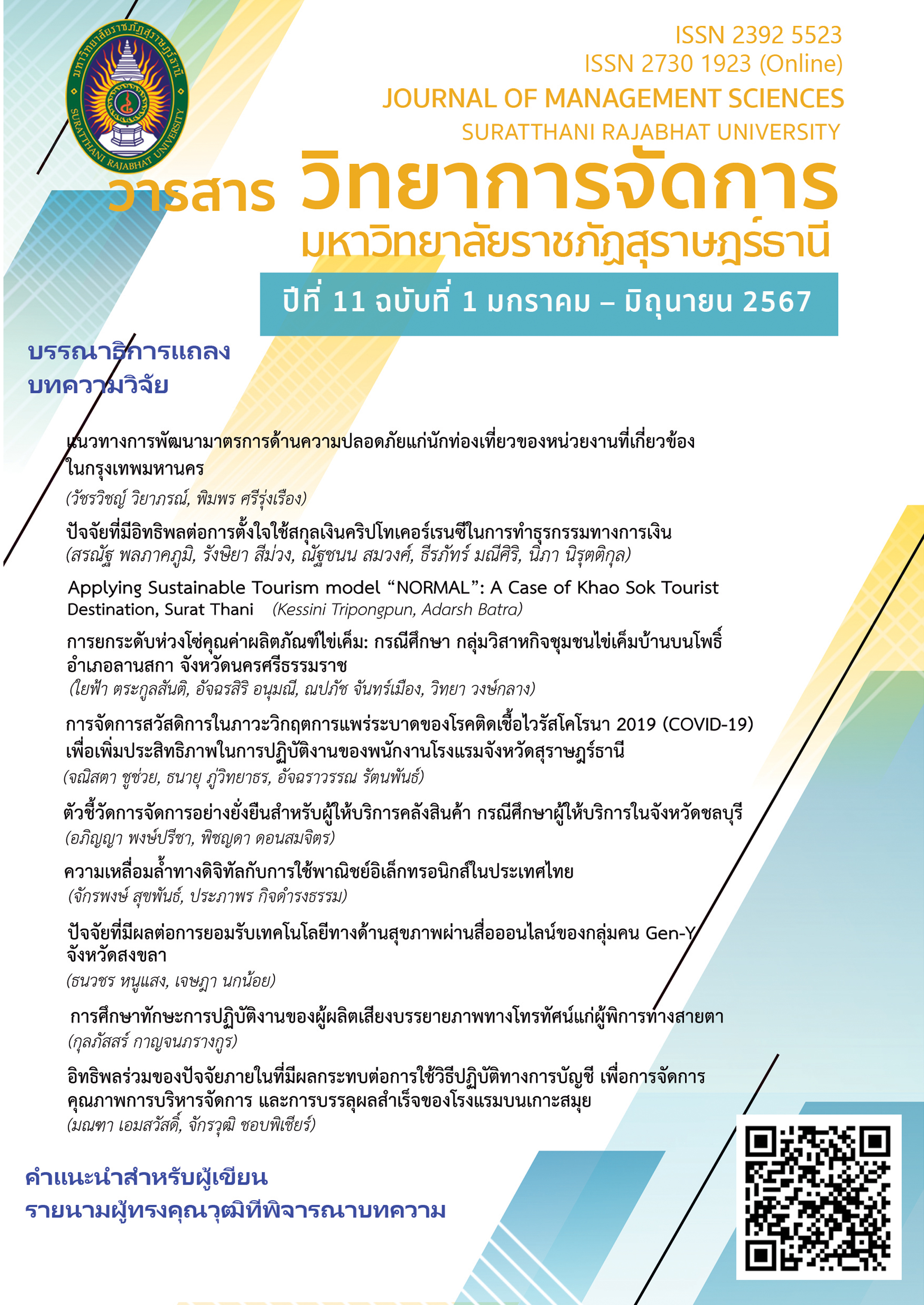Key Performance Indicators for Sustainable Warehouse Management; A Case Study of Third-Party Logistics in Chonburi
Main Article Content
Abstract
Warehousing is one of the logistics activities that matter along the supply chain. Determining performance indicators that they can lead the warehouse to sustainable development. It will affect logistics and supply chain management to sustainability. This research aimed to develop the key performance indicators (KPIs) of logistics service providers in warehousing following the dimensions of sustainable development. The research scope is the warehouse service providers in Chonburi Province. The indicators are collected and validated from literature review and structured interviews with 3 warehouse operators and 5 experts’ opinions. Analytic Hierarchy Process was used to determine the important weight of KPIs based on sustainability experts’ preferences. The result of this study is a set of KPIs for sustainable warehouse operators. The KPIs include 7 economic indicators, 6 social indicators, and 6 environmental indicators. In addition, the most important weight for warehouse sustainability assessment is economic factor (52.26%) followed by social factor (24.99%) and environmental factor (22.75%). The key performance indicators (KPIs) are suitable for general merchandise warehouse operators, which does not provide special services. The public sector can use the key performance indicators (KPIs) from research results as a guideline for improving regulations to promote and control the warehouse operators for further development of warehousing sustainability standards. Warehouse operators can use the finding of this research as a guidance for improving warehouse performance to sustainability.
Article Details

This work is licensed under a Creative Commons Attribution-NonCommercial-NoDerivatives 4.0 International License.
References
Amjed, T. W., & Harrison, N. J. (2013). A model for sustainable warehousing: from theory to best practices. In A. E. Avery (Ed.), 2013 International DSI and Asia Pacific DSI Conference proceedings (pp. 1892-1919). Decision Sciences Institute.
Apiprachaskul, A. (2013). Warehouse and distribution management. Focus media and publishing company limited.
Bouchery, Y., Ghaffari, A., & Jemai, Z. (2010). Key performance indicators for sustainable distribution supply chains: Set building methodology and application. Cahiers de recherche, 8, 37-56.
Department of Business Development. (2019). Thai logistics business...it's time to adjust - change the way of thinking, leading Technology to help manage. Turn competitors into partners. https://www.dbd.go.th/news_view.php?nid=469414627.
Department of International Trade. (2021). Warehouse operators in Chonburi. Ministry of Commerce https://www.dit.go.th/region/CHON%20BURI/Content?id=1369.
Division of Logistics. (2019). Industrial logistics performance index: Key success factor. Department of Industrial of Promotion. Ministry of Industry. https://dol.dip.go.th/en/category/2019-02-08-08-57-30/2019-03-15-09-09-00
Dolgui, A., & Proth, J. M. (2010). Supply chain engineering: useful methods and techniques. Springer.
Eastern Economic Corridor (EEC) Office. (2019). Promotion zone overview. https://www.eeco.or.th/th/promotion-zone-overview.
Elkington, J. (1994). Towards the sustainable corporation: Win-Win-Win business strategies for sustainable development. California Management Review, 36, 90-100. http://dx.doi.org/10.2307/41165746
Frazelle, E. H. (2002). World-Class Warehousing and Material Handling (2nd ed). McGraw-Hill.
Grant, D. B., Trautrims, A., & Wong, C. Y. (2015). Sustainable logistics a supply chain management: Principles and practices for sustainable operations and management. The United States: Kogan Page.
Harrison, A., & Hoek, R. V., (2005). Logistics management and strategy (2nd Edition). Prentice Hall.
Hristov, I., & Chirico, A. (2019). The role of sustainability key performance indicators (KPIs) in implementing sustainable strategies. Sustainability, 11(20), 5742. https://doi.org/10.3390/ su11205742
Klomjit, P. (2013). Logistics and supply chain: introduction to design and management. SE EDUCATION Public Company Limited.
Koskinen, P. (2009). Supply chain strategy in a global paper manufacturing company: a case study. Industrial Management & Data Systems, 109(1), 34-52.
Kusrini, E., Ahmad, A. & Murniati, W. (2019). Design key performance indicator for sustainable warehouse: A case study in a leather manufacturer. Materials Science and Engineering Conference Series, 598, 012042. 10.1088/1757-899X/598/1/012042
Kusrini, E., Safitri, K. N., & Fole, A. (2020). Design key performance indicator for distribution sustainable supply chain management. In 2020 International Conference on Decision Aid Sciences and Application (DASA) (pp. 738-744). https://ieeexplore.ieee.org/stamp/stamp.jsp? tp=&arnumber=9317289&tag=1
Malinowska, M., Rzeczycki, A., & Sowa, M. (2018). Roadmap to sustainable warehouse. In SHS Web of Conferences (Vol.57, p. 01028). EDP Sciences. https://doi.org/10.1051/shsconf/20185701028
Metharutchatakul, A. (2013). Increasing efficiency of warehouse management a case study of automotive part company [Master’s thesis, Burapha University]. http://digital_collect. lib.buu.ac.th/dcms/files/55920046.pdf Context. Business Process Management Journal, Vol. 16 Issue: 5, pp.871-886, https://doi.org/10.1108/14637151011076511
Mihova, L. (2020). The impact of sustainable development on warehousing. In conference procedding draft. 4th international scientific conference eman 2020 (pp. 195-201). file:///C:/Users/66989/Downloads/1094943.EMAN_2020-Conference-Proceedings-DRAFT.pdf
Minashkina, D., & Happonen, A. (2020). Decarbonizing warehousing activities through digitalization and automatization with WMS integration for sustainability supporting operations. In E3S Web of Conferences (Vol. 158, p. 03002). EDP Sciences. https://doi.org/ 10.1051/e3sconf/ 202015803002
Ministry of Industry. (2016). ISO 14004 environmental management systems: general guidelines on environmental management systems and implementation technic. Ministry of Industry
Payel, F. T. (2020). Sustainable warehousing [Bachelor’s thesis, JAMK University of Applied Sciences]. https://www.theseus.fi/bitstream/handle/10024/340015/Farah%20Payel%20Thesis%2018%2005%202020.pdf?sequence=2&isAllowed=y
Richards, G. (2014). Warehouse management: A complete guide to improving efficiency and minimizing costs in the modern warehouse. Kogan Page.
Sub Sri Thai publishing company limited. (2018). Annual Report 2018. https://www.subsrithai.co.th/home.asp?lang=T
Sukjit, S., & Vanichchinchai, A. (2020). An assessment of motivations on green warehousing in Thailand. In 2020 IEEE 7th International Conference on Industrial Engineering and Applications (ICIEA) (pp. 539-542). IEEE.
Tan, K. S., Ahmed, M.D. & Sundaram, D. (2010). Sustainable enterprise modelling and simulation in a warehousing context. Business Process Management, 16, 871-886.
Tatiyamaneekul, V. (2014). AHP advanced decision for organization progress and public well- being. Amarin Printing.
Van den Berg, J. P. (2012). Highly competitive warehouse management. Management Outlook Publising.
Warehousing Education and Research Council (WERC). (2016). Top metrics from DC measures 2016.
World Economic Forum. (2020). The Future of the Last-Mile Ecosystem. https://www.weforum.org/reports/the-future-of-the-last-mile-ecosystem/.


